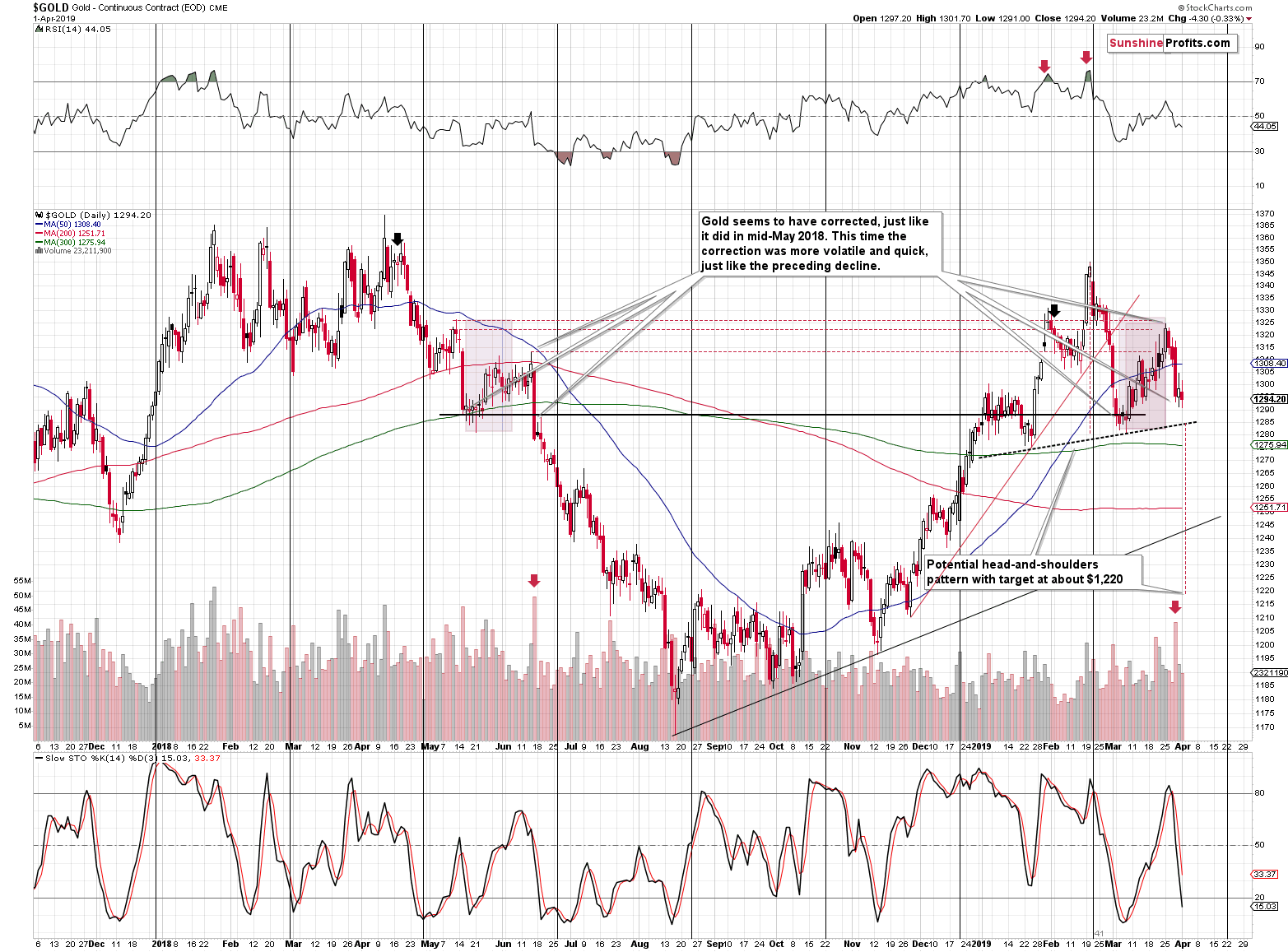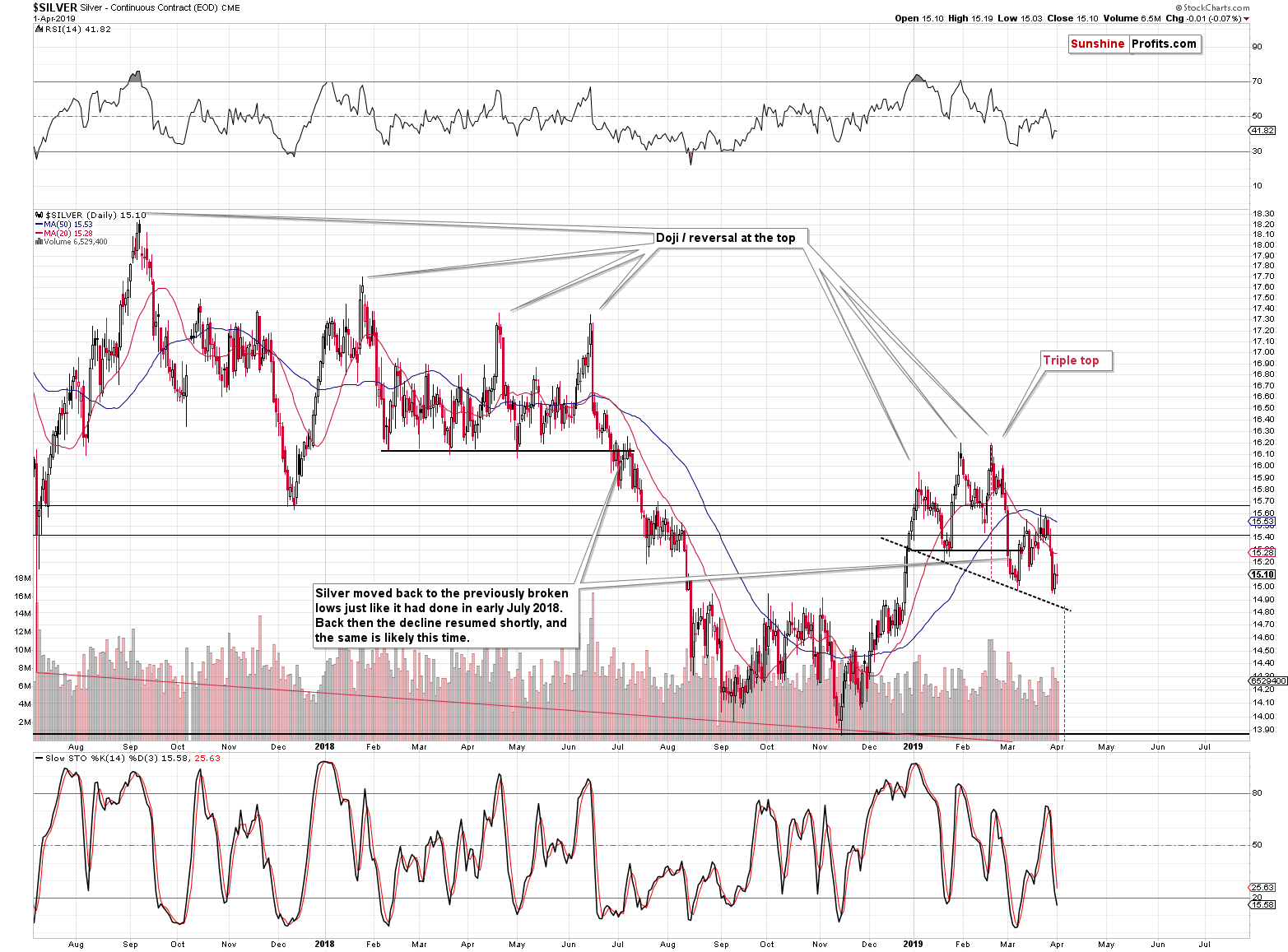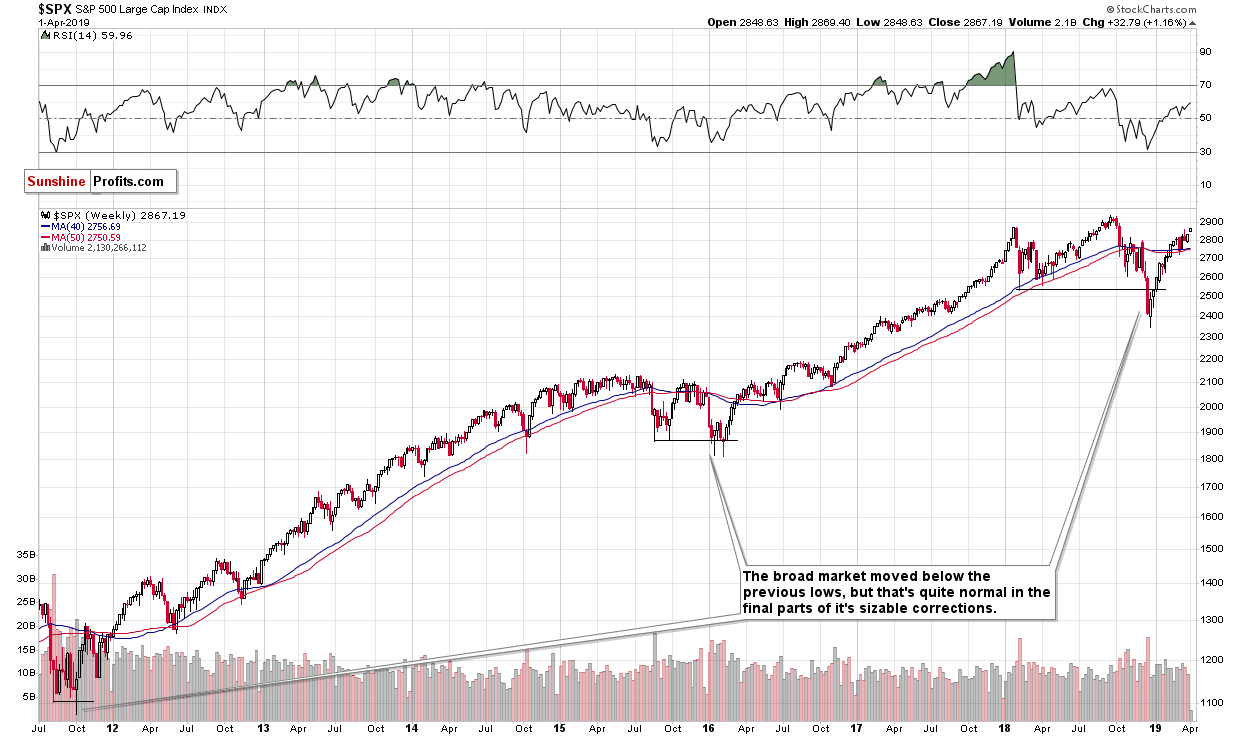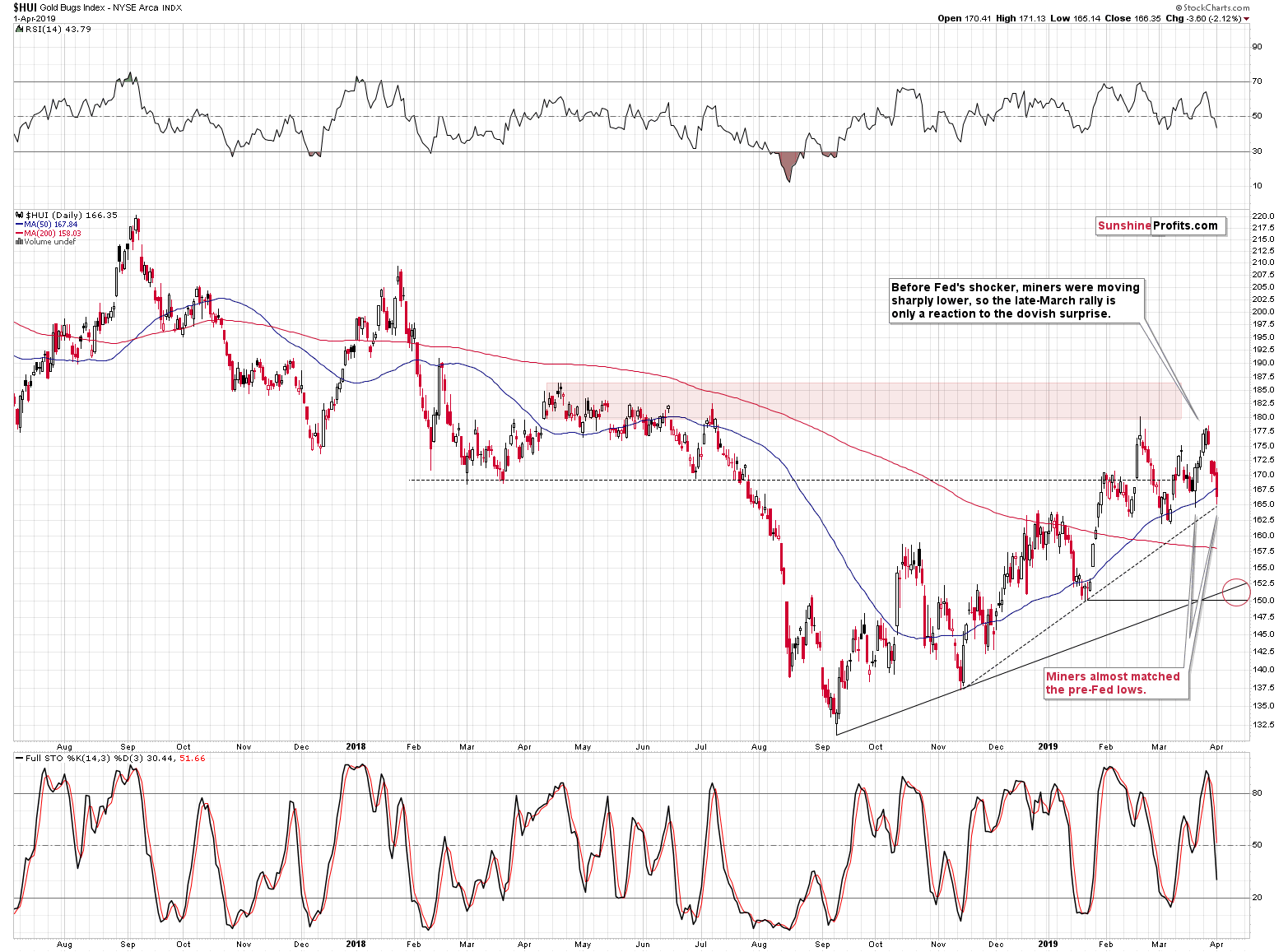Briefly: in our opinion, full (250% of the regular size of the position) speculative short position in gold, silver, and mining stocks is justified from the risk/reward perspective at the moment of publishing this Alert.
Gold didn’t move much yesterday. Silver didn’t move much yesterday. The USD Index didn’t move much yesterday. And the general stock market soared. In such environment, miners should either be moving up or doing nothing. Mining stocks just plunged over 2% on a day when the S&P 500 rallied mover 1%. Could it be the case that the weakness is just temporary and that miners will soon rebound and rally?
It could, but it’s not likely to be the case. The underperformance is the move back to the medium-term trend, so what we saw is normal and it was the preceding outperformance that was odd. We showed you the big picture yesterday, so today’s we’ll update you on the short-term developments regarding this important short-term sign. In fact, that’s the only new indication that we have right now, because – as we have already written – not much else happened and what we wrote previously, simply remains up-to-date.
Let’s start with gold.
Gold and Silver Update
Gold moved back and forth in the last two trading days, but overall it declined a bit – just like it did in mid-June 2018, after the sharp decline. That was just the early part of the decline, which suggests that gold is currently also just starting its decline, not ending it. Let’s keep in mind that once gold declines below the rising dashed black line (another $10+ decline from yesterday’s closing prices), it will complete the head-and-shoulders pattern that points to the target at about $1,220.
Silver outperformed gold on an intraday basis, which is also something that we saw in mid-June 2018. Silver’s quick outperformance is a bearish sign on its own, but the similarity to mid-2018 makes it even more bearish.
Now the USD Index
The USD Index hasn’t done much yesterday, except for correcting on an intraday basis. The USD bears were unable to trigger a substantial decline - the US currency returned to its previous levels.
Gold Stocks in Light of the S&P 500 Performance
The stock market moved visibly higher yesterday. We’re featuring the long-term S&P 500 chart instead of a short-term one because we want to emphasize that the size of yesterday’s daily upswing is in tune with many weekly moves. In other words, the stocks rallied as much in a day, as they used to rally in a week, which proves that the rally was indeed substantial.
This lengthy introduction brings us to the point: miners should have moved either higher or do nothing given the above. At times, miners follow stocks on a very short-term basis and if yesterday was one of those times, they should have rallied. On most occasions, miners move just like the underlying metals, which did next to nothing. Consequently, miners should have simply stayed close to their Friday’s closing price.
Instead, gold stocks moved substantially lower – over 2%. Miners didn’t break below the rising dashed support line based on the November and January lows, but it’s not surprising given lack of bearish indications from gold. What is surprising is that miners moved lower and below the mid-March lows at all.
In fact, miners almost managed to move below their recent intraday low, that was formed right before the Fed’s shocker. This means that the reaction to the Fed’s dovish policy is over even in case of the mining stocks. “Even”, because the impact on the mining stocks is likely greater than the impact on the underlying metals.
We are often asked what needs to happen for gold to decline. And we’re always replying that nothing needs to happen – the market may decline without any real trigger. The situation that we just saw with regard to the Fed confirms it in a way. Taking the last two weeks into account, gold, silver, and mining stocks declined not only without a major bearish trigger – they declined despite a bullish trigger.
Naturally, the news is important on an immediate term basis and can move the market in a quick manner. Our research for the upcoming Day-trading service confirms that it’s best not to make immediate-term trades on the major news days and major option expiration days as the price moves during them can be very chaotic. On a long-term basis, the fundamental information is critical as it ultimately shapes the long-term trends. But, as far as anything in between is concerned, it’s much more useful to check the market’s reaction to a given information instead of focusing on the information alone. In other words, don’t trade the news itself, trade the market’s reaction to the news instead. That’s why gold’s extremely weak reaction to Fed’s dovish surprise was so important. Miners’ weakness is simply a short-term confirmation of what’s coming.
The next short-term (and only short-term) target for gold miners is at about 150 – 152. This is where we have the 2019 lows and the rising support line based on the September 2018 and November 2018 lows. If miners are close to this area while gold moves to $1,240 or so, it might provide an opportunity to temporarily adjust our trading position. It’s too early to say with 100% certainty that it will indeed be the case.
Summary
Summing up, it’s almost certain that the next big move lower has already begun and that the 2013-like slide is in its early stage. Gold’s and miners’ very weak reaction to Fed’s surprisingly dovish remarks strongly confirms the bearish outlook for the following weeks and we can say the same thing about miners’ weakness that we saw yesterday.
If gold declines to $1,240 and the HUI Index moves to about 150, this might be an opportunity to go long, but it’s too early to say for sure at this time. We would like to emphasize that this level is likely to trigger a corrective upswing at most – it’s extremely unlikely to be the end of the entire medium-term decline.
To summarize:
Trading capital (supplementary part of the portfolio; our opinion): Full short position (250% of the full position) in gold, silver, and mining stocks is justified from the risk/reward perspective with the following stop-loss orders and exit profit-take price levels:
- Gold: profit-take exit price: $1,062; stop-loss: $1,357; initial target price for the DGLD ETN: $82.96; stop-loss for the DGLD ETN $39.87
- Silver: profit-take exit price: $12.32; stop-loss: $16.44; initial target price for the DSLV ETN: $47.67; stop-loss for the DSLV ETN $23.68
- Mining stocks (price levels for the GDX ETF): profit-take exit price: $13.12; stop-loss: $24.17; initial target price for the DUST ETF: $76.87; stop-loss for the DUST ETF $15.47
Note: the above is a specific preparation for a possible sudden price drop, it does not reflect the most likely outcome. You will find a more detailed explanation in our August 1st Alert. In case one wants to bet on junior mining stocks’ prices (we do not suggest doing so – we think senior mining stocks are more predictable in the case of short-term trades – if one wants to do it anyway, we provide the details), here are the stop-loss details and target prices:
- GDXJ ETF: profit-take exit price: $17.52; stop-loss: $35.67
- JDST ETF: initial target price: $143.87 stop-loss: $30.97
Long-term capital (core part of the portfolio; our opinion): No positions (in other words: cash)
Insurance capital (core part of the portfolio; our opinion): Full position
Whether you already subscribed or not, we encourage you to find out how to make the most of our alerts and read our replies to the most common alert-and-gold-trading-related-questions.
Please note that the in the trading section we describe the situation for the day that the alert is posted. In other words, it we are writing about a speculative position, it means that it is up-to-date on the day it was posted. We are also featuring the initial target prices, so that you can decide whether keeping a position on a given day is something that is in tune with your approach (some moves are too small for medium-term traders and some might appear too big for day-traders).
Plus, you might want to read why our stop-loss orders are usually relatively far from the current price.
Please note that a full position doesn’t mean using all of the capital for a given trade. You will find details on our thoughts on gold portfolio structuring in the Key Insights section on our website.
As a reminder – “initial target price” means exactly that – an “initial” one, it’s not a price level at which we suggest closing positions. If this becomes the case (like it did in the previous trade) we will refer to these levels as levels of exit orders (exactly as we’ve done previously). Stop-loss levels, however, are naturally not “initial”, but something that, in our opinion, might be entered as an order.
Since it is impossible to synchronize target prices and stop-loss levels for all the ETFs and ETNs with the main markets that we provide these levels for (gold, silver and mining stocks – the GDX ETF), the stop-loss levels and target prices for other ETNs and ETF (among other: UGLD, DGLD, USLV, DSLV, NUGT, DUST, JNUG, JDST) are provided as supplementary, and not as “final”. This means that if a stop-loss or a target level is reached for any of the “additional instruments” (DGLD for instance), but not for the “main instrument” (gold in this case), we will view positions in both gold and DGLD as still open and the stop-loss for DGLD would have to be moved lower. On the other hand, if gold moves to a stop-loss level but DGLD doesn’t, then we will view both positions (in gold and DGLD) as closed. In other words, since it’s not possible to be 100% certain that each related instrument moves to a given level when the underlying instrument does, we can’t provide levels that would be binding. The levels that we do provide are our best estimate of the levels that will correspond to the levels in the underlying assets, but it will be the underlying assets that one will need to focus on regarding the signs pointing to closing a given position or keeping it open. We might adjust the levels in the “additional instruments” without adjusting the levels in the “main instruments”, which will simply mean that we have improved our estimation of these levels, not that we changed our outlook on the markets. We are already working on a tool that would update these levels on a daily basis for the most popular ETFs, ETNs and individual mining stocks.
Our preferred ways to invest in and to trade gold along with the reasoning can be found in the how to buy gold section. Additionally, our preferred ETFs and ETNs can be found in our Gold & Silver ETF Ranking.
As a reminder, Gold & Silver Trading Alerts are posted before or on each trading day (we usually post them before the opening bell, but we don't promise doing that each day). If there's anything urgent, we will send you an additional small alert before posting the main one.
=====
Latest Free Trading Alerts:
In February, the World Gold Council released the newest edition of Gold Investor. What can we learn from the report? Let’s discuss gold’s role in the onslaught of the cashless society, its role as a portfolio diversifier, reverse asset and source of liquidity.
Cash Usage Down, Gold Correspondingly Up?
=====
Thank you.
Sincerely,
Przemyslaw Radomski, CFA
Editor-in-chief, Gold & Silver Fund Manager








